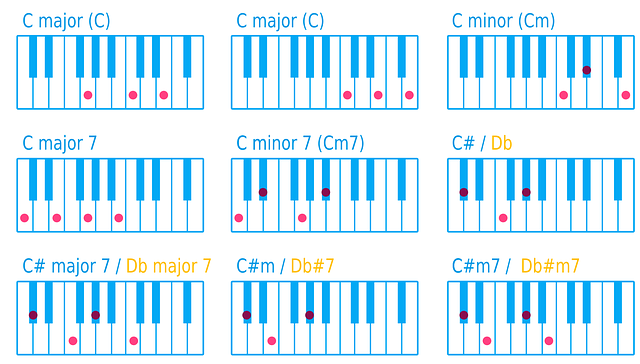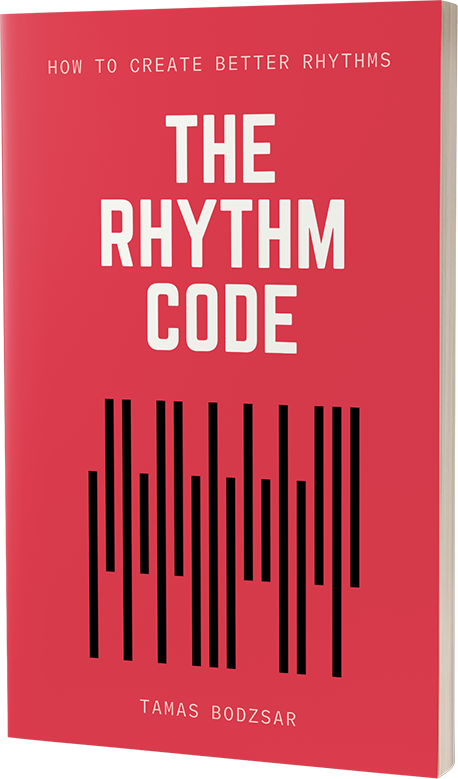
In a previous post, we talked about diatonic chords in detail. Diatonic chords are the chords that are inside the key. But sometimes it gets boring writing songs with only diatonic chords, and we need something to make our chord progression more colorful and exciting.
This is when we utilize borrowed chords. Borrowed chords are chords that are not inside the key: we borrow them from another key. One of the borrowed chords often used in songs is the flat 6 chord.
Let’s see what is a flat 6 chord, and how we can use it in our songs.
Instead of chord symbols (like for example, “Cm7”), it’s often useful to use roman numerals, so it’s easier to understand the relations between chords. We start the numbering with the tonal center, so the “I.” chord is the C major chord in the key of C major.
The sixth chord is the Am, which we write as “VIm“. Therefore, the flat 6 chord is marked as bVI (or bVIm if it’s a minor chord!) which is the Ab chord in the key of C major. Keep in mind that there is no modulation happening here! The song is still in the key of C major.
The flat 6 chord brings more excitement into a chord progression – compared to if you only use diatonic chords. Though the truth is, so many songs are using the flat 6 chord, that our ears are got used to it, so you might be not even aware if a song uses it.
So let’s see a few songs, for example, to see how successful songwriters use the flat 6 chord.
Songwriters and music tutors usually speak about the flat 6 chord as a “borrowed” chord. But I like to think about it as a substitute chord.
What does it substitute? It substitutes the main subdominant chord: the IV or F major chord if we are in the key of C major.
(You can learn everything about chord substitutions from our online course here.)
So if we have a regular IV – V – I cadence (F – G – C), we can substitute the IV chord with the flat 6 chord like this:
bVI – V – I
Ab – G – C
You can easily find the flat 6 chord in any key if you start from the tonal center, and step down a major triad. In the key of C major, it’s the Ab. In the key of F major, the flat 6 chord is the Db. It’s that simple.
Let’s take a look at the chord progression of the chorus from the song “Hero” by Nickelback.
G – A – B
bVI – bVII – I
The song is in the key of B major, so if we make a major third step down, the flat 6 chord is the G major chord. And we can see a cadence of “subdominant – dominant – tonic” in the chorus.
I always like to transpose the chord progressions into the key of C major because it’s easier to understand everything in that key. So here is the same chord progression in the key of C major:
Ab – Bb – C
bVI – bVII – I
I encourage you to play this simple chord progression on a piano or guitar so your ear gets used to the sound and FEELING of the flat 6 chord!
Now let me confuse you a little bit. 🙂 Take a look at the chord progression of the song “No Tears Left To Cry” by Ariana Grande:
A – F – G
And listen to the song here:
Does it sound like a flat 6 chord? Compare to the sound of the previous song. If you do the math, you might think that this song is in the key of A major, so the chords are I – bVI – bVII.
But this is not the case. There is no flat 6 chord in this song!
You always need to check the melody. Because the melody tells us that this song is in the key of C major, so the A major chord is a borrowed chord, and the chord progression is:
VI – IV – V
A – F – G
It’s also important to know that the flat 6 chord is NOT a borrowed / substitute chord if the tonal center is a minor chord!
For example, let’s take a look at the chord progression in the song “Underdog” by Alicia Keys:
Cm – Ab – Bb – Eb Bb/D
You might think that the song is in the key of C minor, so the flat 6 chord is the Ab. But actually, the song is in the key of Eb major, so the chord progression is:
VIm – IV – V – I V/3
Cm – Ab – Bb – Eb – B/D
Technically, we can say that the verse is in the Aeolian mode, but the point is that the Ab is not a borrowed / substitute chord, so we don’t have the effect in this case.
So if we transpose the chord progression into the key of C major:
Am – F – G – C G/B
VIm – IV – V – I V/3
The flat 6 chord can be used not only as a triad but as a seventh chord. For example, in the song “Happy” by Pharrell Williams, he starts the chorus with the flat 6 chord not as a triad but as a major 7 chord:
Dbmaj7 – Cm7 – Cm7 – F
bVImaj7 – Vm7 – Vm7 – I
The song is in the key of F major, so if we step down a major triad, the flat 6 chord is the Db. The major 7 chord sounds really bright and “happy”, and also smooth. In this case, the main subdominant chord would be the Bb major chord (IV), and the Db chord substitutes this chord.
Here is the same chord progression in the key of C major:
Abmaj7 – Gm7 – Gm7 – C
bVImaj7 – Vm7 – Vm7 – I
Nirvana also used the flat 6 chord in their song “Smells Like Teen Spirit”. This chord progression is very unique because they use two substitute chords. The song is in the key of F major, so the flat 6 chord is again, the Db:
F – Bb – Ab – Db
I – IV – bIII – bVI
In the key of C major:
C – F – Eb – Ab
I – IV – bIII – bVI
As you can see, you can use the flat 6 chord at the end of a chord progression, right before the tonic I. chord, as it goes around like a loop. The same thing is happening in the song “Don’t Give Hate a Chance” by Jamiroquai.
The chord progression of the chorus starts with the tonic I. chord, which is the F# chord, and ends with the chord Dmaj7 which is the flat 6 chord:
F# – Bm/D – C#m7 – B – Amaj7 – Dmaj7
I – IVm/3 – Vm7 – IV – bIIImaj7 – bVImaj7
The same chord progression in the key of C major:
C – Fm/Ab – Gm7 – F – Ebmaj7 – Abmaj7
I – IVm/3 – Vm7 – IV – bIIImaj7 – bVImaj7
I know it looks weird, but it is still in the key of C major! If you want to learn why, and you want to learn how to create these kinds of unique chord progressions, you can go through our songwriting course.
There is a very special use of the flat 6 chord in the song “Sir Duke” by Stevie Wonder. He utilizes the blues scale in the melody in a very unique way. The song is in the key of B major and he uses the blues scale G# – B – C# – D – D# – F# in the melody. However, the note D doesn’t belong to the key!
So his solution at that part of the song is using the flat 6 chord, which is the G major chord, and this chord contains that D note:
B – G#m – G – F#
I – VIm – bVI – V
Here is the same chord progression in the key of C major:
C – Am – Ab – G
I – VIm – bVI – V

(In this key, the blues scale is: A – C – D – Eb – E – G)
This is a very clever way of utilizing the blues scale in a way that it matches the chord progression – or more like the chord progression matches the melody!
Another example is the song “Every Little Thing She Does Is Magic” by Sting. (By the way, I created a salsa cover of this song, listen to my version here: https://spoti.fi/35IYJXo )
Here is the chord progression of the chorus in the original key:
A – D – A – D – A – D – A – Bb
IV – I – IV – I – IV – I – IV – bVI
And in the key of C major:
F – C – F – C – F – C – F – Ab
IV – I – IV – I – IV – I – IV – bVI
As you can see, the chorus is alternating between the I and the IV chord, and it closes with the flat 6 chord, which is unexpected and unique.
Conclusion
– You can use the flat 6 chord if you want to bring some excitement into a chord progression that only consists of diatonic chords.
– You can substitute the IV chord with the flat 6 chord.
– You can put the flat 6 chord at the end of a chord progression if the next chord (the first chord of the loop) is the I. tonic chord.
– You can use the flat 6 chord if you want to utilize the blues scale in the melody.
– You can use the flat 6 chord not only as a triad but also as a major seventh chord.
The secret pattern behind successful songs
Get the eBook for $4.99

